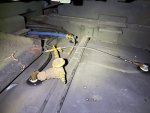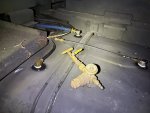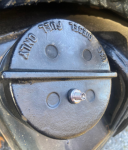-
Steel Soldiers now has a few new forums, read more about it at: New Munitions Forums!
losing prime after a week m929
- Thread starter bowlerman
- Start date

More options
Who Replied?- 4,437
- 3,743
- 113
- Location
- Fort Worth, Texas
It sounds like you have an A2 truck. Replace the soft fuel line between the primary fuel filter and the lift pump. If that doesn't solve it then inspect the lift pump (could have failed push button), bad fuel lines near tank selector valve (if tractor, dump, or wrecker), or in tank hard lines. They tend to rot at times.
- 4,437
- 3,743
- 113
- Location
- Fort Worth, Texas
You can pressurize the fuel tank to 5 psi and open the bleeder nut on the back side of the injection pump. It's closer to the radiator and 10mm. Be gentle with it when tightening it. Push fluid until it stops bubbling.should i pressure the lines to see if i have aleak? or i was thinking about using a smoke machine?
- 2,756
- 2,414
- 113
- Location
- Sunman Indiana
Same procedure, minus the bleed screw. Air is going in where you see fuel coming out. Just be careful pressurizing the tank, it doesn’t take much pressure to turn a cube into a cylinder.
- 2,756
- 2,414
- 113
- Location
- Sunman Indiana
Yes, a typical paint gun regulator plugs in between the quick connect on the end of your air hose, and your air tool/fuel tank. Most guys drill their fuel cap for a valve stem and wing it. Adding air pressure until they hear the tank starting to swell, with the tank vents trying to act as a regulator.

This is my setup where I can just quickly hook it up in the vent lines and get a nice steady low pressure “2-3psi”, while I go search for leaks, or prime the fuel system. Checking back at the gauge on the regulator periodically.

A lot of guys here will quote anywhere from 5-100psi. I used to build and pressure test pontoons that were odd pentagon shaped vessel’s 3/16” thick and 4’ long. We would take them to about 3psi and it was amazing the amount they would pop, bang, and swell at just a few psi!
Also on the 8.3, be sure you’re holding the throttle wide open when cranking to start after you bleed the air out of the fuel system. It should fire off way before 30 seconds if bled properly and batteries are good.

This is my setup where I can just quickly hook it up in the vent lines and get a nice steady low pressure “2-3psi”, while I go search for leaks, or prime the fuel system. Checking back at the gauge on the regulator periodically.

A lot of guys here will quote anywhere from 5-100psi. I used to build and pressure test pontoons that were odd pentagon shaped vessel’s 3/16” thick and 4’ long. We would take them to about 3psi and it was amazing the amount they would pop, bang, and swell at just a few psi!
Also on the 8.3, be sure you’re holding the throttle wide open when cranking to start after you bleed the air out of the fuel system. It should fire off way before 30 seconds if bled properly and batteries are good.
Defcon-1
Member
- 86
- 67
- 18
- Location
- South New Jersey
Might be a little crude, but, a good way to pressurize the fuel system:
- They were like < $4 on Amazon lol. I figured I would (eventually) have fuel problems with regard to priming so I wanted to pre-install a quick way to pressurize the tank haha. Also, always use a pressure regulator with pneumatics, it's never good to have your tools (or in this case, a fuel tank) experience a sudden shock of PSI instead of slowly building it up via a regulator, cheap insurance I'd say.

- They were like < $4 on Amazon lol. I figured I would (eventually) have fuel problems with regard to priming so I wanted to pre-install a quick way to pressurize the tank haha. Also, always use a pressure regulator with pneumatics, it's never good to have your tools (or in this case, a fuel tank) experience a sudden shock of PSI instead of slowly building it up via a regulator, cheap insurance I'd say.

Last edited:
Defcon-1
Member
- 86
- 67
- 18
- Location
- South New Jersey
Hmm I had no idea about this, is this also somewhere in the operators manual? I'm new to the truck (and Diesels in general) so still trying to learn all the tricks of the trade.Also on the 8.3, be sure you’re holding the throttle wide open when cranking to start after you bleed the air out of the fuel system. It should fire off way before 30 seconds if bled properly and batteries are good.
- 2,756
- 2,414
- 113
- Location
- Sunman Indiana
Not sure on the TM’s.
@WillWagner pointed this out on here years ago and it made an incredible difference in cranking time from my experience. I would dare to guess it would be the same with the mechanical cummins B, Ford, and IH motors that use the same type of injection pumps as well. I have no clue on the nhc250 motors as they are a different type of injection system.
@WillWagner pointed this out on here years ago and it made an incredible difference in cranking time from my experience. I would dare to guess it would be the same with the mechanical cummins B, Ford, and IH motors that use the same type of injection pumps as well. I have no clue on the nhc250 motors as they are a different type of injection system.
- 8,698
- 3,205
- 113
- Location
- Monrovia, Ca.
No need to bleed, the Bosch in lines are self bleeding and will start if they have a boosted fuel supply, just put the pedal to the wood. I do know the A2 has issues with the pick up and lines. Easy way to tell if it is an engine or chassis issue is to eliminate the chassis and pull fuel from a clean bucket of fuel into the lift pump. Start the engine, run it a bit to get the air out of the system and shut it down. After the time passes that you know that the engine will not start, give it a try. If it lites, chassis issue. If not, not too many things on the engine, lift pump, overflow valve or something inside the pump. MOST of the time, it is a failed overflow valve, however, if the engine has been operated with a junk overflow, that can cause the lift pump to work its arse off and fail. Cummins required some sort of filtration prior to the engine, before the lift pump. The reason is that FOD can get into the check valves in the lift pump and cause this same type of issue. High restriction can cause the same issue
If you have the means, hook up some gauges and a clear line. Install a restriction gauge before the lift pump...this measures restriction from the tank to the engine, IIRC, 5 inches of vacuum max.
A pressure gauge at the inlet of the filter...this gives you lift pump and filter inlet pressure. Lift pumps are capable of 70 PSI, but the overflow valve regulates the pressure to around 20-30 PSI, that is about where you should see the pressure.
A clear line looped like a roller coaster loop from the outlet of the filter to the fuel pump inlet....2 purposes for this. One to see if there is air in the system, the second to see if the fuel bleeds off from either side. Bleed off from the filter side, a filter with no o-ring on the spud, a failed or leaking lift pump check valve. Bleed from the pump side, a failed overflow valve or a failed fuel pump.
A gauge on the outlet of the filter...2 reasons for this. One, to measure the pressure drop across the filter, 4 PSI less than inlet pressure, maximum. This equals a fuel restriction across the filter. Second reason, to see what the overflow valve is doing. There used to be be 3 different overflow valves for the A. MW and P pump, but I believe that they are all the same now. A good valve will see 30- 35 PSI wide open, no load. 25 is OK, any less, i'd say replace it and re check things. The valve SHOULD hold positive pressure with the engine stopped for a bit, slowly dropping off. If the pressure is good when checking and when shut off, the pressure drops like a bad habit, the valve is junk.
Another hard start thing that happened was the FSOV. Trombetta FSOVs were very problematic. These trucks had them when new, IIRC. They were switched to the Synchrostart brand. Trombettas liked to break the link causing the shut off lever to not be put into the run state, they kinda hung out half way through the stroke. Synchrostart can do kinda the same thing but it is the coil that causes this by not pulling the piston its full travel. Somewhere here I scanned the chart for the measurements the solenoids needed to put the pump in full run mode.
There are a couple other things that can cause a hard start, the pump and/or injectors. If all of the low pressure pressures, restriction and air checks are good, it can be the above. My advice to customers if all the checks were cood was try injectors first since that is the least expensive thing to do.
Another clue about hard starting or starting and dying, guess this might no apply in this case, but just incase this happens and not remembered. If there is an issue with the plumbing on the chassis and the engine components are in good order, the engine will crank and start like normal, but after 30 seconds or so, then dies then the system need pumping of the lift pump, it is a chassis air introduction/drain back issue.
A funny thing about air sucking through at clamps, fittings, filter seals and drain valves, small cracks in pick up tubes in the tank is that sometimes one can pressure and vacuum test things all day long and will have no outward sign of an issue, but when the engine is actually pulling fuel through the components, you will have a failure you cannot locate and the only thing to do is replace all of the components.
After all that...my fingers and brain hurt now...my armchair QB guess is the overflow valve since it sits a week.
If you have the means, hook up some gauges and a clear line. Install a restriction gauge before the lift pump...this measures restriction from the tank to the engine, IIRC, 5 inches of vacuum max.
A pressure gauge at the inlet of the filter...this gives you lift pump and filter inlet pressure. Lift pumps are capable of 70 PSI, but the overflow valve regulates the pressure to around 20-30 PSI, that is about where you should see the pressure.
A clear line looped like a roller coaster loop from the outlet of the filter to the fuel pump inlet....2 purposes for this. One to see if there is air in the system, the second to see if the fuel bleeds off from either side. Bleed off from the filter side, a filter with no o-ring on the spud, a failed or leaking lift pump check valve. Bleed from the pump side, a failed overflow valve or a failed fuel pump.
A gauge on the outlet of the filter...2 reasons for this. One, to measure the pressure drop across the filter, 4 PSI less than inlet pressure, maximum. This equals a fuel restriction across the filter. Second reason, to see what the overflow valve is doing. There used to be be 3 different overflow valves for the A. MW and P pump, but I believe that they are all the same now. A good valve will see 30- 35 PSI wide open, no load. 25 is OK, any less, i'd say replace it and re check things. The valve SHOULD hold positive pressure with the engine stopped for a bit, slowly dropping off. If the pressure is good when checking and when shut off, the pressure drops like a bad habit, the valve is junk.
Another hard start thing that happened was the FSOV. Trombetta FSOVs were very problematic. These trucks had them when new, IIRC. They were switched to the Synchrostart brand. Trombettas liked to break the link causing the shut off lever to not be put into the run state, they kinda hung out half way through the stroke. Synchrostart can do kinda the same thing but it is the coil that causes this by not pulling the piston its full travel. Somewhere here I scanned the chart for the measurements the solenoids needed to put the pump in full run mode.
There are a couple other things that can cause a hard start, the pump and/or injectors. If all of the low pressure pressures, restriction and air checks are good, it can be the above. My advice to customers if all the checks were cood was try injectors first since that is the least expensive thing to do.
Another clue about hard starting or starting and dying, guess this might no apply in this case, but just incase this happens and not remembered. If there is an issue with the plumbing on the chassis and the engine components are in good order, the engine will crank and start like normal, but after 30 seconds or so, then dies then the system need pumping of the lift pump, it is a chassis air introduction/drain back issue.
A funny thing about air sucking through at clamps, fittings, filter seals and drain valves, small cracks in pick up tubes in the tank is that sometimes one can pressure and vacuum test things all day long and will have no outward sign of an issue, but when the engine is actually pulling fuel through the components, you will have a failure you cannot locate and the only thing to do is replace all of the components.
After all that...my fingers and brain hurt now...my armchair QB guess is the overflow valve since it sits a week.
ODAddict
Well-known member
- 131
- 309
- 63
- Location
- Charlottesville, VA
I had a similar loss of prime problem in a John Deere diesel tractor. If the tractor had been running, it would start easily. The longer it sat without running, the longer it would take to start the next time.
Problem solved: the oil filter gasket was not seating against the canister. Removing and reseating the filter did the trick. Starts on the first bump, and no problems since.
Problem solved: the oil filter gasket was not seating against the canister. Removing and reseating the filter did the trick. Starts on the first bump, and no problems since.
- 8,698
- 3,205
- 113
- Location
- Monrovia, Ca.
Oil filter? How does that make an engine not fire?I had a similar loss of prime problem in a John Deere diesel tractor. If the tractor had been running, it would start easily. The longer it sat without running, the longer it would take to start the next time.
Problem solved: the oil filter gasket was not seating against the canister. Removing and reseating the filter did the trick. Starts on the first bump, and no problems since.
ODAddict
Well-known member
- 131
- 309
- 63
- Location
- Charlottesville, VA
Fuel filter. Fuel filter. Auto correct malfunction? Gaseous intrusion of brain? Maybe consciousness consumed by working on M37 oil leak? Cause will remain forever a mystery. 
- 8,698
- 3,205
- 113
- Location
- Monrovia, Ca.
I thought maybe a BF, but... Even modern electronic engines will still let things come to life with 0 OP, they'll just shut off after a few seconds 
- 6,170
- 4,905
- 113
I believe blue ovals are an exception to that. They force you to crank the engine long enough to build pressure before they'll initially start.I thought maybe a BF, but... Even modern electronic engines will still let things come to life with 0 OP, they'll just shut off after a few seconds
- 8,698
- 3,205
- 113
- Location
- Monrovia, Ca.
Yeah, that's right. 6.0 had to have op to fire. Same engine as the 444E Navistar IIRC, maybe that was 7.3, I forget. Puddy tat, same same, HEUI was their brain child. Did you know that the diamond no longer makes their own engines? MaxxForce killt that part of their business off, HEUI and someones weird long distance, complicated EGR and heated compound turbos killed the Feline's on road production.I believe blue ovals are an exception to that. They force you to crank the engine long enough to build pressure before they'll initially start.
Last edited:
- 114,375members
- 167,258threads
- 2,354,595posts
- 4,146online users
